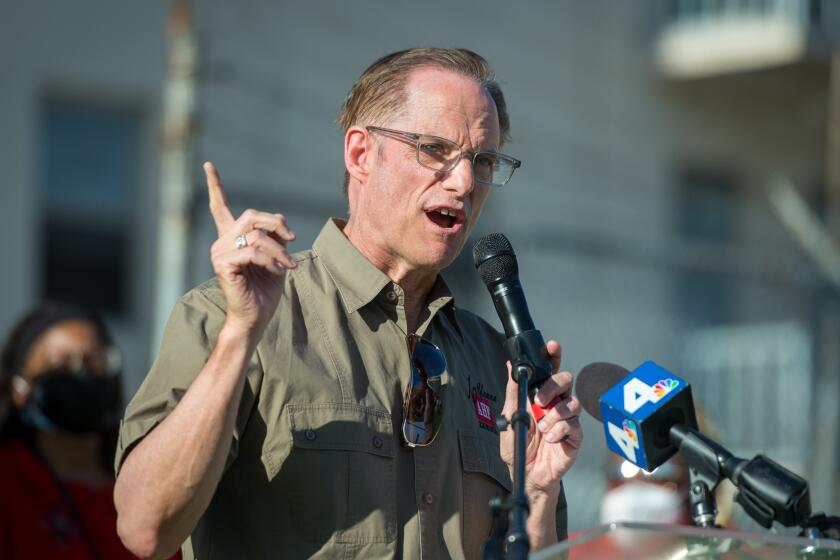Endorsement: No on Proposition 33. This rent control measure could make the housing shortage worse

- Share via
In California, about 55% of renters pay more than 30% of their income on rent and utilities. That makes them “rent-burdened,” according to experts. More than a quarter paid over half their income on rent — making them severely burdened.
For decades, some cities and counties have used rent control to cap yearly increases on tenants as an imperfect but necessary answer to keep people from being priced out of their homes. A 1995 state law called the Costa-Hawkins Rental Housing Act restricts local governments’ ability to expand rent control, and there have been multiple efforts, including two unsuccessful ballot initiatives, to amend or repeal it.
More than 20 cities and counties in California, including Los Angeles, have adopted rent control, but Costa-Hawkins prohibits them from applying rent control to properties built after 1995 (or earlier in cities that already had rent control), single-family homes and condominiums and vacant units.
From the top of the ticket to local ballot measures, California voters this year are grappling with major decisions that will shape their lives and communities for years to come.
Proposition 33 on the Nov. 5 ballot would repeal Costa-Hawkins, allowing cities and counties to enact or expand local rent control laws — or not.
We support rent control, and endorsed two previous initiatives that would have repealed or amended Costa-Hawkins. Both of those measures and this one were put on the ballot by the AIDS Healthcare Foundation, a Los Angeles-based nonprofit. But Proposition 33 goes too far. It includes sweeping language that could make California’s housing shortage even worse by prohibiting the state from imposing any limits on rent controls set by cities and counties in the future. Voters should reject Proposition 33.
Proposition 33 could create all kinds of unintended consequences. Cities that are anti-growth and don’t want any new housing built could use their authority over rent control (diabolically) to require that developers set extremely low rent caps on new apartment buildings, which would make new multifamily housing financially unfeasible.
If we don’t want more homeless people on sidewalks, we have to invest in proposals like Measure A that stand a chance of resolving this horrible problem.
Or a well-intentioned city trying to keep rents affordable could impose “vacancy control” when rents stay capped even after a tenant moves out, or they could put rent control on new construction. Both could have a chilling effect on the one thing that will ultimately solve the problem of rising rents: building more housing, especially affordable housing.
Instead of Proposition 33, the better option is for the Legislature to repeal or amend Costa-Hawkins so cities and counties have more flexibility to tailor local rent control laws to meet their needs — but not so much flexibility that cities could use rent control to stymie, intentionally or inadvertently, housing construction.
AIDS Healthcare Foundation calls this a “revenge initiative,” and we agree. Proposition 34 would change the rules for healthcare providers in ways that seem specifically designed to cut off the foundation’s tenant advocacy.
For example, Costa-Hawkins prohibits rent control on any unit built after Feb. 1, 1995, or earlier in cities that already had rent control in place. That’s why Los Angeles cannot regulate rents on apartments built after Oct. 1, 1978. Lawmakers have previously considered “rolling rent control,” which would slowly expand the number of regulated units by applying rent control to properties as soon as they turned 10 or 15 years old, which would give developers time to pay off costs of a new apartment building with rental income before caps would kick in.
In 2019, the Legislature passed and Gov. Gavin Newsom signed into law California’s first statewide rent control law, which capped rent increases at 5% plus inflation, not exceeding 10% a year. The Tenant Protection Act (Assembly Bill 1482) applies to all jurisdictions, whether they have enacted rent control or not, and includes units that local governments could not regulate because of Costa-Hawkins. It applies to apartment buildings older than 15 years and single-family homes that are owned by corporations.
But that law expires in 2030. Lawmakers should commit to renewing it and tightening the rent caps — those protections guard only against the most egregious rent hikes. Despite fierce opposition from landlords when the law was first proposed, an official of the California Apartment Assn. (which has bankrolled the opposition to Proposition 33) told the editorial board that the association supports the Tenant Protection Act. We’ll remind them of that when a renewal bill is proposed.
The plight of renters is grim as high rents put struggling tenants at risk of having to move out of their homes and neighborhoods. But Proposition 33 isn’t the right vehicle because of the risk that some cities and counties will misuse rent control. Lawmakers owe it to tenants — who make up a large portion of their constituency — to come up with state laws that curb unaffordable rent hikes that can fuel displacement and homelessness, and allow people to live without fearing one more increase will force them out of their homes.
More to Read
A cure for the common opinion
Get thought-provoking perspectives with our weekly newsletter.
You may occasionally receive promotional content from the Los Angeles Times.













